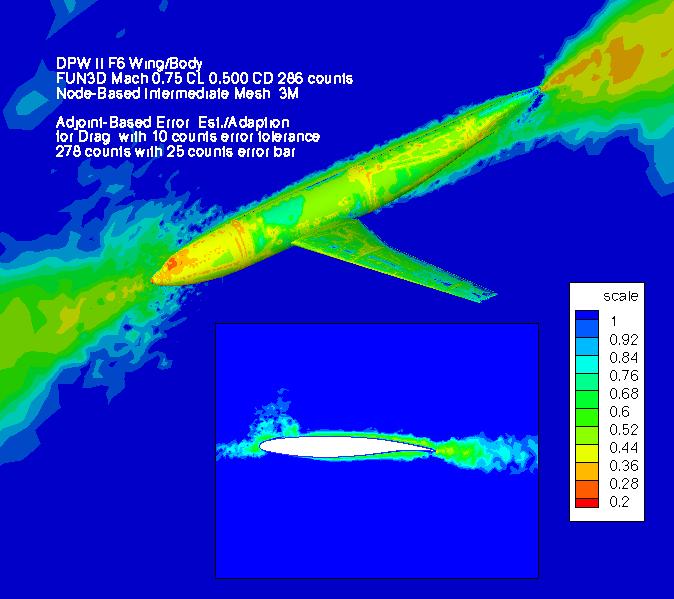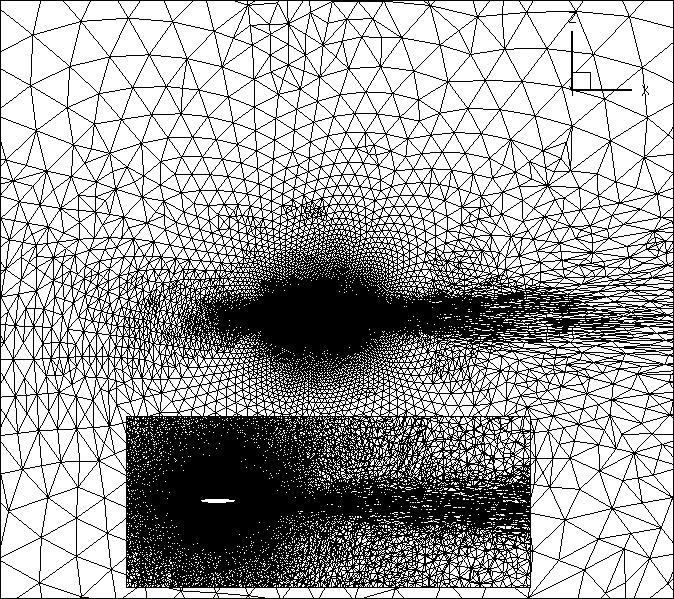Application #39. Adjoint-Based Adaptation Applied to AIAA DPW II Wing-Body
Contributed by Beth Lee-Rausch, NASA Langley
This is a preliminary application of FUN3D’s adjoint-based adaptation procedure to a large-scale turbulent flow case. This case was the focus of a recent AIAA drag prediction workshop, where the goal was to predict the drag on a wing-body configuration as accurately as possible. The plot below shows a uniform grid refinement study for three popular unstructured grid codes—FUN3D, USM3D1, and NSU3D[2].

Note the extrapolated values for the infinitely-refined result for all three codes point away from the experimental result.
The plot below shows the adjoint-based adaptation parameter for the drag coefficient on the FUN3D medium grid in the above plot.

Note the adjoint is requesting much finer resolution along the stagnation streamlines and the wakes.
While FUN3D’s adaptation mechanics allow for moderate grid stretching (roughly 50:1 elements) they do not currently handle the highly-stretched elements typically found in a boundary layer grid. For this reason, the boundary layer grid has been “frozen” for this adaptation demonstration, while the rest of the field is allowed to adapt as needed. Shown below is the grid after 5 cycles of field adaptation.

Approximately 1 million grid points have been added outside the boundary layer region, primarily in the regions flagged above. Note the baseline grid has no wake resolution and the adjoint immediately goes after this area.
Finally, the following is the adjoint-based adaptation parameter after 5 cycles of adapting.

The hot spots along the stagnation streamlines on the symmetry plane have been greatly reduced, and the adjoint is now wanting to hone in on the wake even further. Note the surface still appears yellow, because no adaptation has taken place there in this example.
Now review the plot at the top of this page. The adjoint-based adaptation is actually turning upwards away from the uniform grid refinement and is pointing more towards the experimental result. It is believed that the uniformly-refined grids are so lacking in the wake regions that the wake is not even visible to the uniform grid refinement. Eventually, the wake would appear and presumably the extrapolated curves would reverse direction towards experiment but such a level of refinement may be prohibitive.
1 Neal Frink of NASA Langley.
2 Dimitri Mavriplis of University of Wyoming.
NASA Official: David P. Lockard
Contact: FUN3D-support@lists.nasa.gov
Page Last Modified: 2026-01-16 12:03:13 -0500
NASA Privacy Statement
Accessibility
This material is declared a work of the U.S. Government and is not subject to copyright protection in the United States.

